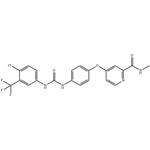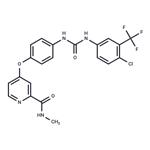Sorafenib: An Important Option for the Treatment of Hepatocellular Carcinoma (HCC)
Jul 30,2025
Globally, the prevalence of hepatocellular cancer (HCC) is increasing. The leading cause of HCC is hepatitis C virus (HCV) infection in Europe, North America and Japan, and hepatitis B virus (HBV) infection in Asia and Africa. Non-viral risk factors for HCC include alcoholic cirrhosis, conditions such as hereditary haemochromatosis and nonalcoholic steatohepatitis. Advanced HCC has a poor prognosis and treatment options are limited. Sorafenib (Nexavar) was approved in the EU and the USA for use in HCC in 2007, and remains the only systemic agent approved for use in this indication. This article will briefly introduce the mechanism, and safety of sorafenib in HCC.[1]

Figure 1. Mechanism of action of sorafenib.[2]
Mechanism
Sorafenib is an orally administered multikinase inhibitor. It inhibits multiple cell surface tyrosine kinases [e.g.vascular endothelial growth factor receptor (VEGFR)-1, VEGFR-2, VEGFR-3, platelet-derived growth factor receptor (PDGFR)-β, KIT, FLT-3, RET, RET/PTC] and downstream intracellular serine/threonine kinases in the MAPK cascade [e.g. wild-type BRAF, mutant BRAF and CRAF (Raf-1)]. These kinases are involved in tumour cell signalling, proliferation, angiogenesis and apoptosis. In vitro, sorafenib inhibited the proliferation of HCC cells and induced their apoptosis, as well as inhibiting tumour growth, reducing tumour angiogenesis and inducing tumour cell apoptosis in animal models of HCC.
In brief, sorafenib affects several cell signalling pathways in addition to the MAPK pathway (e.g. downregulation of p-STAT3); this is of relevance given that various additional cell signalling pathways are implicated in the initiation and progression of HCC (e.g. the PI3K/Akt/mTOR, JAK/STAT, Wnt/β-catenin, cMET and IGF pathways). Sorafenib also induces tumour cell death via various MAPK-independent mechanisms, including downregulation of anti-apoptotic Bcl-2 proteins such as Mcl-1 and increased expression of p53-upregulatedmodulator-of-apoptosis (PUMA). It has also been suggested that sorafenib may have immunomodulatory effects, such as enhancing the activity of tumour-specific effector T cells and reducing suppressive immune cell populations.
Safety
Oral sorafenib was generally well tolerated in patients with advanced HCC, with a manageable adverse event profile. In the SHARP trial, drug-related adverse events of any grade occurring in significantly (p< 0.05) more sorafenib than placebo recipients included diarrhoea (39 vs.11%), hand-foot skin reactions (21 vs. 3%), anorexia (14 vs. 3%), alopecia (14 vs. 2%), weight loss (9 vs. 1%), dry skin (8 vs. 4%), abdominal pain (not otherwise specified) [8 vs. 3%] and voice changes (6 vs. 1%). Grade 3 drug-related adverse events reported in significantly (p < 0.05) more sorafenib than placebo recipients included diarrhoea (8 vs. 2%), hand-foot skin reactions (8 vs. <1%) and weight loss (2 vs. 0%). The only grade 4 drug-related adverse event reported among sorafenib recipients was fatigue (1 vs. <1% in placebo recipients). A similar tolerability profile was seen in the Sorafenib AP trial.
References
[1] Keating, G.M. Sorafenib: A Review in Hepatocellular Carcinoma. Targ Oncol 12, 243–253 (2017).
[2] Management of Common Adverse Events in Patients Treated With Sorafenib: Nurse and Pharmacist Perspective.
doi: 10.1053/j.seminoncol.2014.01.002
- Related articles
- Related Qustion
- The brief introduction of Sorafenib Apr 1, 2024
Sorafenib is a multikinase inhibitor that has recently obtained Food and Drug Administration (FDA) approval for the treatment of advanced renal cell carcinoma (RCC).
- Sorafenib: A kinase inhibitor Feb 15, 2023
Sorafenib is a medicine that targets proteins in cancer cells and stops the cancer cells from growing. It is used to treat liver cancer, thyroid cancer, or kidney cancer.
Supplementation with pyridoxal 5'-phosphate monohydrate can synthesize neurotransmitters such as dopamine and serotonin, maintaining a healthy nervous system.....
Nov 4,2025Biochemical EngineeringCinacalcet is a calcimimetic agent that increases the sensitivity of the calcium-sensing receptor to activation by extracellular calcium.....
Jul 30,2025APISorafenib
284461-73-0You may like
- Sorafenib tosylate
-

- 2025-12-14
- CAS:284461-73-0
- Min. Order:
- Purity: 0.99
- Supply Ability:
- Sorafenib
-

- $34.00 / 50mg
- 2025-12-14
- CAS:284461-73-0
- Min. Order:
- Purity: 99.69%
- Supply Ability: 10g
- Sorafenib
-

- $34.00 / 50mg
- 2025-12-14
- CAS:284461-73-0
- Min. Order:
- Purity: 99.69%
- Supply Ability: 10g






